For god’s sake, please don’t get a Bowflex! They don’t work well, and they are always relegated to coat racks before long.
And don’t get any other machine, for that matter. At least not yet.
Hundreds of thousands of people have learned to do what I’m about to describe. It’s the #1 proven setup for a home gym. It’s what almost everyone needs, male or female, young or old, to start a weight training program that will get them results. It’s common knowledge among people who know what they’re doing. Any experienced lifter knows that this is the most obvious basic setup for a beginner or intermediate lifter.
This article covers the equipment. As far as the exercises go, see the Gym Junkies article on beginner workouts with the main exercises you should be learning.
A basic weight training setup will let you do the big compound freeweight exercises – squats, deadlifts, bench presses and other presses, and pull ups. Any equipment that has those basics covered can be used for a bunch of other exercises too, which I’ll get into further below.
Table of Contents
Why These Exercises?
Compound exercises are ones that work multiple muscle groups at once. The reason this is important:
- It’s a Time Saver
You can get as much of a full body workout, or better, from a few compound exercises as you can a dozen isolation exercises - You Release Growth Hormones
Lifting heavy weights taxes your entire system. Your muscles struggle, your heart starts pounding, you sweat, and you mentally have to push yourself, which stimulates your central nervous system. This releases hormones that tell your body to get stronger. It doesn’t like being too weak to accomplish a task easily. Your nervous system doesn’t take you seriously unless your whole body is struggling. - You Become Functionally Stronger
Your body is smart. It wants to function smoothly and effectively as a unit. It wants to be athletic. Compound movements require not only strength, but coordination and balance. When you do only isolation exercises, one muscle group at a time such as with curls or many machine exercises, your body will not let one muscle group get too strong if it will throw off the balance.
For example, if you work your abs too much and not your back, your back might start hurting and you won’t get the six-pack you want. Likewise, if you work your biceps and not your triceps, your biceps will be limited in how strong they are allowed to get.
Basically, compound movements are more effective at accomplishing strength and fitness goals.
Isolation exercises can be used too, as I describe below, but they are a supplement. It’s mainly just professional bodybuilders and top athletes who can use a lot of isolation exercises because of the amount of time they spend in the gym daily. When you only have an hour per day, including warmup, it doesn’t make sense.
What You Need
With 3 basic pieces of equipment, you can create a solid weight training program.
Briefly, they are:
- Rack
A rack will hold the barbell at the right height for you to do squats and presses. - Bench
Slide it into the rack and do barbell bench presses. Or take it out of the rack and do dumbbell exercises. - Barbell Weight Set
A barbell and a pile of weight plates.
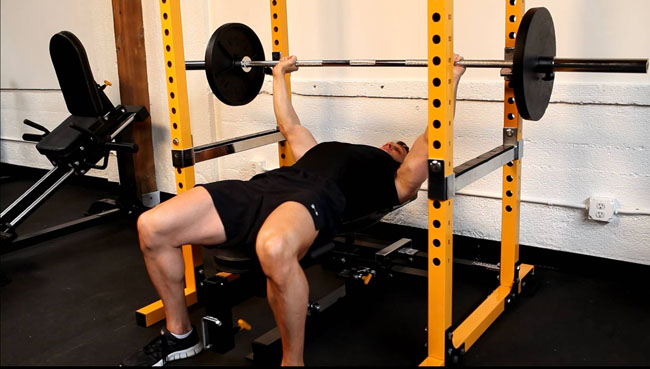
Let’s go over each of these in more detail, and how they also provide for lots of other exercises.
Rack
With a rack you can do lots of stuff. Squats are the most common. Bench presses are next up (which requires a bench, below).
With squats the barbell is usually sitting on your upper shoulders, and trust me, you don’t want to try to lift it off the floor, up over your head, and try to set it down on your shoulders in some kind of soft way without hurting yourself. Weight training is supposed to be hard work, but that’s just awkward. We don’t like awkward. That’s asking for an injury. That’s why we have our beloved racks.
So the primary function of any rack is to hold the barbell up at your preferred height so you can lift it off easily to do exercises without having to awkwardly lift the damn thing off the floor into position.
And as a bonus, off the floor, it’s also easier for you to add and remove weight plates between sets.
Note: The barbell does NOT touch the rack while you’re lifting. You do true freeweight barbell exercises. A Smith machine, which you may have also seen, holds the bar and restricts movement to a straight plane of motion. The rack I’m talking about is not a machine. You do 100% of the work once you lift the weight off the rack.
But the really cool thing about racks is some of them have safety bars. They turn an awesome heavy freeweight exercise into something safe that you don’t need a friend standing by to spot you for. You simply move the safety bars down to the “here’s where things are going South” height, just below your normal range of motion, and they’ll catch the barbell when you fail on that last heavy rep. No crushed throat from a failed bench press. No broken back from a failed squat. It’s beautiful.
The best kind of rack is a power rack. Why power? I don’t know, that’s just what they call it. You walk into it and you’re sort of surrounded. It still gives you enough space to do the freeweight barbell exercises, but if you should fail or fall over, it will catch the bar if it falls down, forwards, OR backwards. It’s got you covered. Very little can happen to you that way. It’s not even a mishap. You breathe a sigh of relief, unload the weight plates, move the barbell back up, and try again. An idiot could do that over and over and be able to walk away. And lots of us are idiots.
The other type is generally called a half rack (or squat stand). It’s simpler and doesn’t always have safety bars.
Just get a power rack. But if you’re digging for more information, see: Choosing Between a Power Rack and Half Rack.
Any rack has adjustable-height barbell holders. Depending on how tall you are, and what exercise you’re doing, you set the barbell at what ever height is most comfortable for you, and then load the weight plates and start lifting.
That’s basically it. That’s how it works. Piece of cake. Once you’ve used one or two racks, they’re all the same. Sometimes folks see big guys doing some serious heavy lifting in a rack and they get intimidated by the whole thing. Trust me, if the muscleheads can figure it out, it will take you about 10 seconds.
So on to the other exercises you can do with it.
- Pull Ups
They figured, Well, we have this nice sturdy rack… Why not put a pull up bar on it? So they did. - Lunges
Preferably reverse lunges, where you’re just stepping each foot backwards and staying in place, not “walking” around. - Calf Raises
If you can do squats, you can do calf raises. Same setup position. - Bicep Curls
Honestly this is one of the pet peeves of regular gym-goers who are always waiting to use the rack because some jerk is doing endless sets of curls in the rack and they want to get serious and do some squats. You don’t really need a rack for curls. Anything you can curl you can lift up off the floor easily enough. But hey, if you have a rack to yourself, why not, use it for curls! - Overhead Presses
Depending on your height, and how tall the rack is, you might actually bang the barbell into the top of the rack when you do these. So you can also do them on the outside of the rack, instead of inside it, but usually there are no safety bars you can hang on the outside of the rack, so be careful.
A budget-friendly option at the moment is the Titan T-2 power rack.
Bench
Throw a bench into the mix and it only gets better.
This type of bench doesn’t have any barbell holders on it. It’s also called a dumbbell bench. We already have the rack, so any barbell holders built into the bench will get in the way and are just stupid.
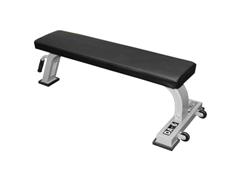
Slide the bench inside the rack and you’re ready to do bench presses.
A basic flat bench will work great.
If you get a bench with an adjustable backrest, you can also do incline and decline presses, which work slightly different muscle groups and add variety. But for flat bench pressing, nothing beats a simple flat bench. Because nothing on it moves, it’s more stable, feels more solid, and there’s no separate butt and back pads that have uncomfortable gaps between them.
See: 6 Ways a Flat Bench is Better than an Adjustable Bench
Barbell Weight Set
Ok, so you obviously need weights for this to work.
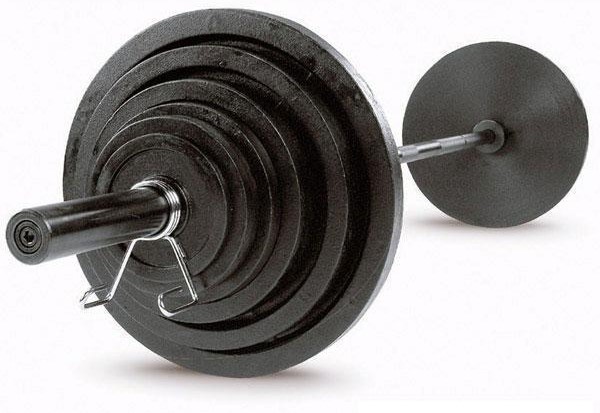
The easiest thing to do is just buy a 300lb weight set, which includes a 7ft barbell and all the weight plates you will need for a long time to come if you’re a beginner.
Now hold on. I hear your thoughts. 300 lbs? That’s way more than I need!
Buying a 300lb set doesn’t mean you expect to lift anywhere near 300 lbs. It’s about the convenience of being able to load larger weights instead of having to load and unload lots of smaller weights. Two 45lb plates plus the bar is 135 lbs, and without the 45lb plates you would have to rely on the smaller weights. And admit it, it just feels good to be able to use the big plates. As far as using all the plates, someone lifting 225 lbs will at some point up to that amount need to use all the different sized weights.
You can also opt for a 210lb set, which is the same as a 300lb set but without the 45lb plates. A better suggestion is to skip the 35lb plates. They aren’t actually necessary to cover all the total weight possibilities. But for either of these you may need to buy each piece individually, and we offer the best deals on 300lb weight sets.
Your next question: 35lb? 45lb? What the hell? Why not 50lb, 20lb, etc?
I hear you. You learn to the do the math before long. This was an unfortunate conversion from kilogram denominated weights. We Americans are proud of our wonky imperial units of measure, so that’s just the way it is.
Anyway, these barbell sets are perfect for bench presses, squats, deadlifts, military presses, and many other exercises preferred by bodybuilders, powerlifters, and anyone else that wants to lift weights a bit to get in shape.
By the way, if you’re building your own olympic weight set instead of buying one of the pre-compiled sets, we recommend you get two of each size weight plate, but four of the 5lb plates. This is because of the large jump between 10lb and 25lb, creating a weight gap at some points that you won’t be able to fill without some extra 5lb or 10lb weights.
A 300lb set usually consists of:
- Olympic Barbell (weighs 45 lbs)
- Collars to secure plates on the bar
- 2 x 45lb plates
- 2 x 35lb plates
- 2 x 10lb plates
- 4 x 5lb plates
- 2 x 2.5lb plates
- Total weight of set: 300 lbs.
Other Items
You can get a lot out of the above setup of a rack, bench, and 300lb weight set. But to add more variety to keep yourself interested and motivated, and to work your muscles in different ways to ensure you’re progressing as well as you possibly can, it’s smart to add a few more things. They will really flesh out your home gym.
Weight Storage Tree
Were you just planning on throwing your plates on the floor? Get a weight tree and be civilized.
Dumbbells
The next item most people get is some kind of dumbbell set or adjustable dumbbells. The most space-saving option is adjustable dumbbells.
The bench you already got for use with the power rack is also a dumbbell bench, so you can just slide it out of the rack and use it alone.
If you have the space and the budget, solid dumbbells are much more satisfying to lift. You can get a 5-50lb set or add 60 lbs and up as needed. Being able to add another couple plates onto adjustable dumbbells isn’t quite as satisfying as moving on to the bigger dumbbells that have thus far set there on the rack untouched. There’s something about being able to use the big toys.
Lat Machine
A lot of folks can’t do a pull up. For them, a lat machine is the answer. Even if you can do a few pull ups, you can get a lot out of a lat machine because the pulley systems facilitate other exercises, as explained below.
You’ve certainly seen them at commercial gyms. A seat and a bar you pull down to your chest, just like a pull up but with as light weight as you need instead of having to pull your body weight.
They’re called lat machines because the lat pull down exercise generally works your lat (lattisimus dorsi) muscles that go from under your armpits , down the sides of your ribcage, and down to your lower back. Biceps and other muscles are involved too.
The thing with a lat machine is it isn’t just a lat machine. Every lat machine has another pulley near the floor, so you can do all kinds of exercises where you pull upwards or sideways. Possibilities include seated rows, curls, glute kickbacks, leg extensions, leg curls, and other less common exercises.
Some power racks have an optional lat attachment, basically a lat machine that extends out the rear of the power rack, out of the way of any squats or presses you would do inside the rack. But beware – a lot of these attachments use bushings that the carriage slides on. This can be ok, but it won’t be as friction-free as carriages that roll on bearings like those you’ll see in a commercial gym. The bushings can wear a little over time if you use it a lot, increasing the friction even more. The friction never actually gets severe enough to prevent you from doing the exercise, but it doesn’t feel nearly as good.
Power Bar
Otherwise known as a powerlifting bar. It looks much like any other olympic barbell at first glance. If you didn’t already buy one of the premium 300lb weight sets with a power bar included, you might want one of these eventually. It will hold up better when you drop it hard on the rack (although any bar may bend if you load it up enough and drop it from high enough), there are no bolts on the ends that come loose, and the knurling is a little deeper to give you a better grip.
Lifting Platform
For home gyms, most people just put down some extra rubber mats for doing deadlifts or cleans on and call it good. The point is to be able to drop the weight without damaging the floor underneath.
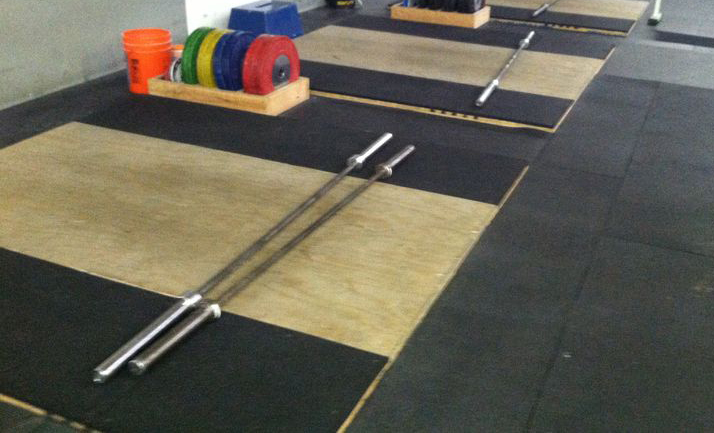
A lifting platform is a specially designed unit that has hardwood for you to stand on, rubber on both sides for the weight plates to impact, and a metal frame to hold them all together. There’s also wood underneath the layer of rubber, so the platform does a really good job of absorbing a good portion of the impact from drops, cutting out some noise and vibration. It helps to prevent angry conversations with family and neighbors about porcelain falling off shelves, babies being woken up, or just a nice neighbor frantically wondering if your car fell on top of you in your garage.
Bumper Plates and A Better Olympic Bar
Bumper plates are solid rubber and can be dropped without damage, assuming it’s onto rubber mats or a platform as described above.
If you’re going to be doing snatches or cleans, as in Crossfit style workouts where you’ll drop the bar from shoulder height or from overhead, you will also need a better olympic bar that is strong enough to hold up to those drops, has soft knurling to avoid ripping up your hands, and spins better to facilitate the movements.
Dip Bars and Belt
Dips are great. Dip handles might be an available attachment for your particular power rack.
If not, you can fashion a pair of dip bars by laying two barbells (you already have one, with the weight set) side by side onto the safety bars of your power rack. Instant dip station. Of course, the bars want to roll a bit, and people have come up with some ways to make this better, but just try it first and then see about holding them in place with something if you have to.
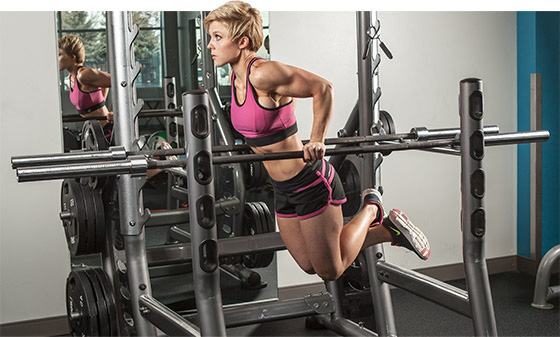
To add weight to dips, there’s a special kind of belt called a dip belt. It looks like it couldn’t possibly stay in place, but no, it hangs off your butt or hips really well once you put a weight plate to the chain.


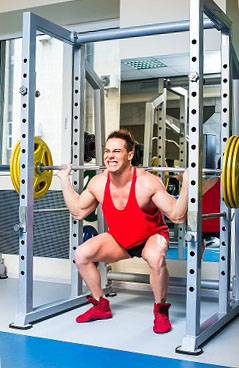
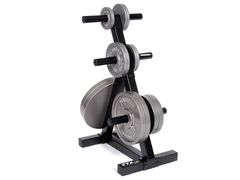
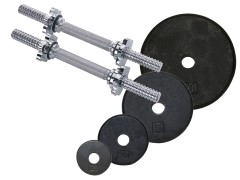
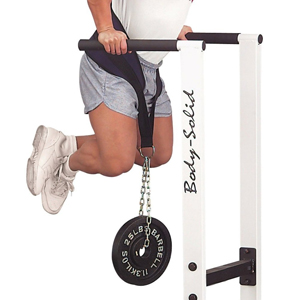
Thanks for this summary! I’ve been putting together the pieces one by one and finding this gives me confidence I’m on the right path.
In fact I found this page looking for your advice on dip stations. Two bars on a rack? Well, I only have one bar, and I have low ceilings so I only have a stand, Rogue’s SML-1, which, annoyingly, is supposedly not compatible with their dip station attachment.
I noticed Amazon sells basic freestanding dip stations for $70. Have you offered your thoughts on these anywhere?
The taller ones on Amazon ought to be fine. The equalizer bar type things are not tall enough to do weighted dips with a dip belt.
The SML-1 can fit any monster lite dip attachment. Rogue recommends against it because of tipping risk.
Awe man brother! You summed up the foundational growth beautifully!
Both beginners and veteran lifters who start drifting into the isolated movements, just have be reminded to stay compound, or remember to treat isolated movements as supplements… I’m about to be 59, and needed what you so beautifully stated stated about clinging to the compound lifts!
Thank you Brother!
Thanks for sharing, Hamo! Compound lifts are so important!